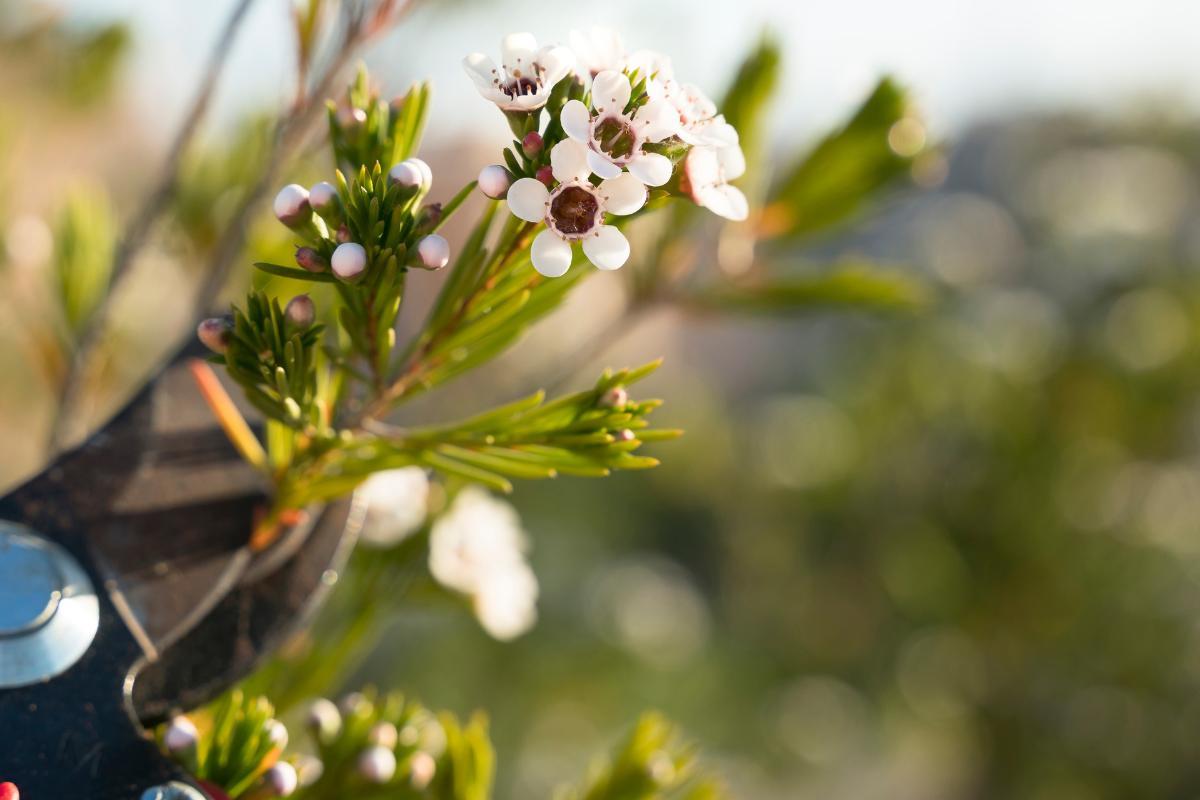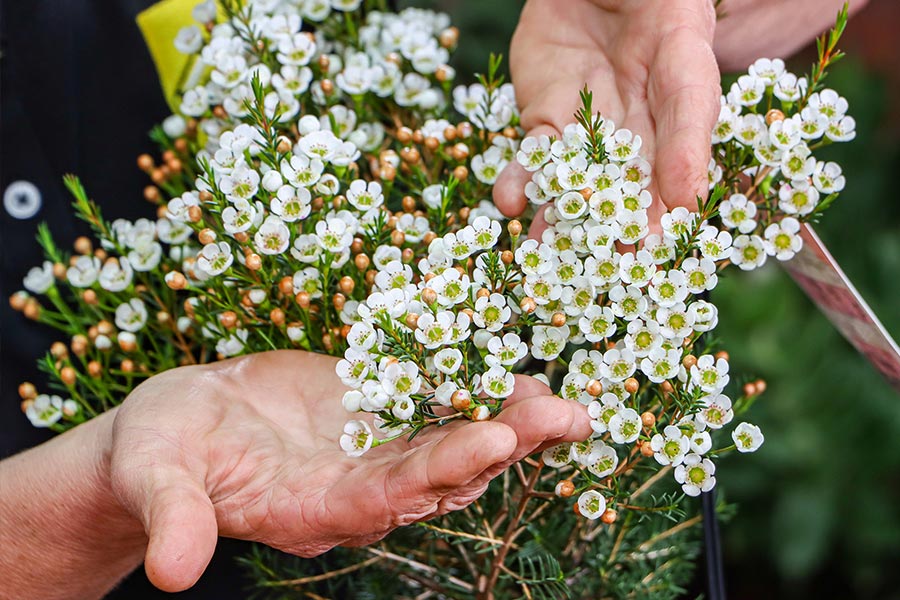
The Unassuming Charm of the Geraldton Wax Plant: A Comprehensive Guide to Care and Culinary Delights
The Geraldton Wax Plant, scientifically known as Chamelaucium uncinatum, is a true gem of the Western Australian flora. Renowned for its delicate, star-shaped flowers and its resilience, this hardy shrub brings a touch of understated elegance to any garden or floral arrangement. While its common name might suggest a simple, waxy texture, the reality is a plant that thrives with minimal fuss, rewarding its caretakers with a profusion of vibrant blooms and a subtly fragrant aroma. This comprehensive guide will delve into the intricacies of Geraldton Wax Plant care, ensuring your shrub flourishes and even exploring its lesser-known culinary potential.
Understanding the Geraldton Wax Plant: A Native Marvel
Originating from the sandy soils and arid conditions of Western Australia, the Geraldton Wax Plant is a testament to nature’s ingenuity. It’s a member of the Myrtaceae family, which also includes eucalyptus and tea trees, explaining its hardy nature and aromatic foliage. The plant typically grows as a rounded shrub, reaching heights of 1-3 meters, though some varieties can be more compact or sprawling. Its leaves are needle-like, leathery, and possess a distinct, pleasant fragrance when crushed, reminiscent of wax, hence its common name.

The true stars of the show, however, are its flowers. Appearing in late winter and spring, these small, waxy blooms are clustered in abundance along the stems, creating a breathtaking display. They come in a range of colors, from soft pinks and whites to vibrant purples and reds, each petal often featuring a darker center. Their long vase life makes them a favorite in the floral industry, but their beauty is equally captivating when enjoyed in their natural habitat.
Cultivating Success: Essential Geraldton Wax Plant Care
Despite its origins in challenging environments, the Geraldton Wax Plant is surprisingly adaptable and forgiving, making it an excellent choice for both novice and experienced gardeners. Here’s a breakdown of its essential care requirements:
1. Sunlight: The Golden Rule
The Geraldton Wax Plant is a sun-worshipper. It thrives in full sun, requiring at least six to eight hours of direct sunlight per day. Insufficient sunlight will lead to leggy growth, reduced flowering, and a less robust plant. When choosing a location, ensure it receives ample light throughout the day, ideally with protection from harsh afternoon sun in extremely hot climates.
2. Soil: Drainage is Paramount
As a native of sandy, well-drained soils, the Geraldton Wax Plant is highly susceptible to root rot if planted in heavy, waterlogged conditions. Excellent drainage is non-negotiable. The ideal soil mix is sandy, loamy, and slightly acidic to neutral. If your garden soil is heavy clay, amend it generously with coarse sand, gravel, or perlite to improve drainage. Raised beds are also an excellent option for ensuring proper water runoff. Avoid overly rich, organic composts, as these can hold too much moisture.
3. Watering: Less is More

Once established, the Geraldton Wax Plant is remarkably drought-tolerant. Overwatering is the most common cause of failure. Allow the soil to dry out completely between waterings. Stick your finger about two inches into the soil; if it feels dry, it’s time to water. During prolonged dry spells, occasional deep watering will suffice. Young plants may require more frequent watering until their root systems are well-established. In container gardening, ensure pots have drainage holes and water thoroughly until it runs out the bottom, then allow the soil to dry out.
4. Temperature and Climate: A Love for Warmth
Geraldton Wax Plants are best suited to warm, temperate climates. They tolerate heat well but are not frost-hardy. In regions with significant frost, it’s advisable to grow them in pots that can be moved to a sheltered location during winter or to provide protection with frost cloth. They thrive in coastal areas due to their tolerance for salt spray.
5. Fertilizing: A Light Touch
These plants are not heavy feeders. Over-fertilizing can lead to weak, sappy growth and reduced flowering. A light feeding in early spring, just as new growth begins, with a balanced, slow-release fertilizer or a low-phosphorus formula (as high phosphorus can be detrimental to some native plants) is usually sufficient. Avoid fertilizing in late summer or autumn, as this can stimulate new growth that is vulnerable to frost.
6. Pruning: Shaping and Encouraging Blooms
Pruning is crucial for maintaining the shape, health, and flowering potential of your Geraldton Wax Plant. The best time to prune is immediately after flowering has finished. This allows the plant to recover and produce new growth for the following season.
- Tip Pruning: Regularly pinch back the tips of new shoots during the growing season to encourage bushier growth and more flower buds.
- Maintenance Pruning: After flowering, remove spent flower stalks and any dead, damaged, or crossing branches.
- Shaping: Prune to maintain a desired shape, whether it’s a compact mound or a more open form. Avoid pruning too hard into old, woody growth, as this can be slow to regenerate.
7. Propagation: Spreading the Beauty
The Geraldton Wax Plant can be propagated from cuttings or seeds.
- Cuttings: Semi-hardwood cuttings taken in late spring or early summer are the most successful. Dip the cuttings in rooting hormone and plant them in a well-draining potting mix. Keep them moist and in a warm, humid environment until roots form.
- Seeds: Seeds can be sown in autumn or spring. They may require a period of cold stratification (exposure to cold temperatures) to break dormancy. Sow them in a well-draining seed-starting mix and keep them moist. Germination can be slow and erratic.
8. Pests and Diseases: Resilience Personified
The Geraldton Wax Plant is generally a tough and disease-resistant plant. However, like any plant, it can occasionally be susceptible to:
- Root Rot: As mentioned, this is primarily caused by poor drainage and overwatering.
- Aphids and Spider Mites: These can sometimes infest new growth. A strong jet of water or insecticidal soap can usually manage them.
- Mealybugs: These white, cottony pests can also be treated with insecticidal soap or rubbing alcohol on a cotton swab.
Ensuring proper growing conditions – especially excellent drainage and adequate sunlight – is the best defense against most problems.
Beyond the Bloom: Culinary Potential of the Geraldton Wax Plant
While primarily appreciated for its ornamental value, the Geraldton Wax Plant also holds a fascinating, albeit less common, culinary secret. The nectar from its flowers can be collected and used to create a unique and delicious syrup. This is a traditional practice among some Indigenous Australian communities.
Harvesting and Preparing Wax Flower Syrup:
- When to Harvest: The best time to harvest nectar is during the peak flowering season, typically late winter to spring, on a warm, sunny day.
- How to Harvest: Gently shake the flowering stems over a clean container or use a small brush to collect the glistening nectar from the base of the flowers. Be mindful not to damage the plant.
- Processing: The collected nectar is very sweet and can be used directly in small quantities. For a syrup, it’s typically concentrated by gently simmering it with a small amount of water.
Recipe Ideas Featuring Geraldton Wax Flower Syrup:
It’s important to note that the yield of nectar from a single plant might be small, making this a special treat rather than an everyday ingredient. Experimentation is key, and start with small quantities to gauge the sweetness and flavor.
1. Geraldton Wax Flower Simple Syrup
This is the base for many other applications.
- Ingredients:
- 1 cup freshly collected Geraldton Wax Flower nectar
- 1/4 cup water (optional, adjust for desired consistency)
- Instructions:
- Combine nectar and water (if using) in a small saucepan.
- Heat gently over low heat, stirring until the nectar is fully dissolved and the mixture is slightly thickened. Do not boil vigorously, as this can diminish the delicate flavor.
- Remove from heat and let cool completely.
- Pour into a clean, airtight glass bottle or jar and store in the refrigerator. It should keep for a few weeks.
2. Wax Flower Infused Sparkling Water
A refreshing and subtly sweet beverage.
- Ingredients:
- 1-2 tablespoons Geraldton Wax Flower Simple Syrup
- Sparkling water or soda water, chilled
- Ice cubes
- Optional garnishes: a sprig of mint, a thin slice of lemon or lime
- Instructions:
- Pour the simple syrup into a glass.
- Fill the glass with ice cubes.
- Top with chilled sparkling water.
- Stir gently and garnish as desired.
3. Wax Flower Glazed Fruit Skewers
A delicate sweetness for fresh fruit.
- Ingredients:
- Assorted fresh fruits (strawberries, melon, grapes, pineapple, etc.), cut into bite-sized pieces
- Wooden skewers
- 2-3 tablespoons Geraldton Wax Flower Simple Syrup
- Optional: a pinch of finely chopped fresh mint
- Instructions:
- Thread the fruit pieces onto the skewers.
- Lightly brush the fruit skewers with the simple syrup just before serving.
- If using, sprinkle with finely chopped mint.
4. Wax Flower Drizzle for Desserts
Elevate cakes, ice cream, or yogurt.
- Ingredients:
- Geraldton Wax Flower Simple Syrup, to taste
- Instructions:
- Drizzle the simple syrup generously over your favorite desserts. The subtle floral notes add a unique dimension.
Important Considerations for Culinary Use:
- Source: Ensure your Geraldton Wax Plant is grown organically and without pesticides if you intend to use its nectar for consumption.
- Moderation: The nectar is very sweet. Use it sparingly, especially when starting out, to avoid overwhelming other flavors.
- Allergies: As with any new food ingredient, be mindful of potential allergies.
Conclusion: A Rewarding Companion
The Geraldton Wax Plant is more than just a beautiful flowering shrub; it’s a resilient and rewarding plant that brings a touch of Australian charm to any landscape. With its straightforward care requirements – ample sun, excellent drainage, and judicious watering – it’s a joy to cultivate. And for the adventurous, its subtle floral nectar offers a unique opportunity to explore the sweet side of this unassuming, yet captivating, native. Whether gracing your garden with its vibrant blooms or adding a delicate sweetness to your culinary creations, the Geraldton Wax Plant is a true treasure worth cherishing.


